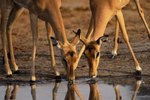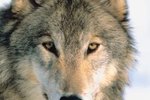
Saudi Arabia is the largest country in the Middle East, and 95 percent of its land is desert. Permanent rivers do not exist and there's limited plant life, yet a variety of animals are indigenous to this arid climate. Among others, these include mongooses, snakes, goats and vultures. All desert animals are fascinating -- and some are endangered.
Desert Ship
The one hump on Arabian camels can store up to 80 pounds of fat. This fat is broken down for nutrients and energy, and can sustain the camel for up to 100 miles. Their thick lips allow them to eat thorny vegetation, and thick hooves keep them stable over rocky terrain and shifting sand. When they do have access to water, they can drink up to 30 gallons in minutes. Arabian camels have been domesticated for thousands of years, and in some cultures owning a number of them is a sign of prosperity.
Lone Wolf
Although camels are abundant, the numbers of Arabian wolves are declining quickly. These small wolves weigh approximately 40 pounds and are a subspecies of the North American grey wolf. They dissipate body heat through panting and their larger-than-normal ears. They also keep cool by digging burrows in the ground. They are constant hunters and hunt mostly at night. They not only prey on small desert animals, but also domestic livestock. For years their main threat has been retaliating farmers who shoot, trap or poison them.
Nomadic Antelope
Arabian oryxes are desert antelopes that live a nomadic way of life. They apparently have the ability to predict rainfall from far away and will travel long distances for the fresh vegetation that grows afterwards. Their white coats reflect sunlight, and their wide hooves keep them surefooted in the sand. Hunted for food and their skin, in the 1970s they were extinct in the wild. However, conservation effects were successful and, since the 1990s, they’ve been reintroduced back into their native environments. Since then, poaching has also increased in numbers.
Small Cat
With a weight of about 7 pounds, sand cats are the smallest cats in Arabia. They are also the only species of cat found in true desert habitats. Their water needs are fulfilled through their prey.They feed on a variety of small desert animals that may include other indigenous species such as fat sand rats and Arabian fat-tailed scorpions. Although wild, these cats have a docile nature, and in the 1960s they were collected for use in the pet trade -- where many died in captivity.
Big Cat
Arabian leopards are the largest cats in Arabia, but they are one of the smallest leopard species overall. They’re also one of the rarest animals in the world, with only an estimated 250 individuals left. Their typical prey includes Arabian tahr, gazelles and hares. The hunting of their prey by humans has impacted the leopard’s decline as well as farmers killing them to protect their livestock. Conservation efforts are being made through nature reserves. However in order for these efforts to be successful, the human vs. leopard conflict must be lessened and reserves must be economically beneficial.
References
Photo Credits
-
Jupiterimages/Photos.com/Getty Images
Writer Bio
Slone Wayking worked as a professional in the veterinary field for 20 years. Though her interest in animal health led to this path, Wayking initially studied creative arts. She has been article writing for more than a year and is currently working towards her degree in multimedia. Her certifications include business writing and basic web design.




